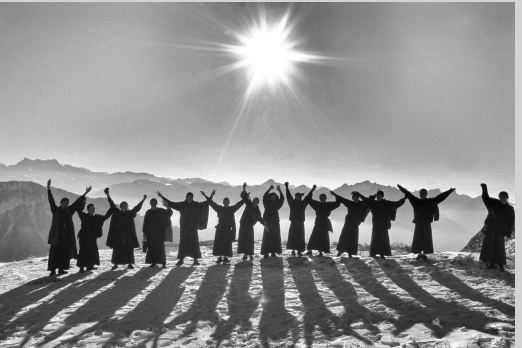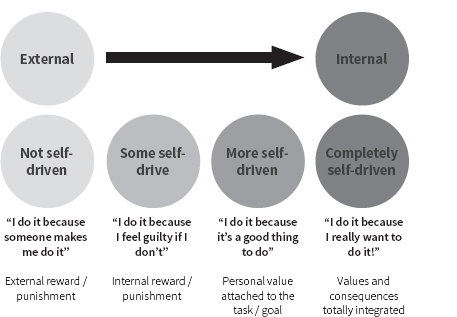11

CHAPTER 11 INSPIRATION
“Instead of focusing on how much you can accomplish, focus on how much you can absolutely love what you’re doing”
Leo Babauta1
Inspiration is the process of being stimulated, mentally, to do or feel something. It’s also about stimulating or inspiring others, and there is an element of generating ideas and creativity within the word. It’s that internal, intrinsic motivation – internal, intrinsic motivation – the inner “why” that inspires us to action.
Inspiration is that mode of decision-making that really enables us to tap into our intuition and fulfil our destiny.2 Inspiration propels us from apathy to possibility, transforming the way we perceive our own capabilities. According to Scott Barry Kaufman, “inspiration can be activated, captured and manipulated, and it has a major effect on important life outcomes.”3
We can draw inspiration from ourselves at our very best. As captured by Martine Wright,4 “one of my motivations is I truly believe I was meant to do this journey” after her paralympian debut in the women’s sitting volleyball team.
As well as spontaneous and illuminating inspiration that comes from within and from the impact of our actions on ourselves and others, inspiration comes a wide range of other sources too: people, books (a passage or quote, a poem or prose), songs, music and other art forms, and, of course, from the truly spectacular natural world that we live in.
When we ask people we’re working with to share who they draw inspiration from, there are some commonalities such as Mahatma Ghandi and Nelson Mandela, some outliers, such as Hitler, and many more varied examples from people’s own lives and experience including parents, school teachers, colleagues and public figures of all kinds from authors and artists to celebrities and politicians. What makes one inspiring over another is entirely subjective.
Martine Wright’s team members see her as inspirational: Emma Wiggs, her Paralympics GB team mate, says; “She’s incredible, she gels everyone together in the team. Her story, her profile, is what inspires me to get up at 5am in the morning to go to the gym so I can train alongside her.”
Inspiration is spontaneous, focusing people beyond self-serving concerns, moving them towards new ideas.5 Inspiration enables people to transcend their current horizons, to energize forward towards contemplating possibilities.
In our organizational work, leaders are often scrutinized as sources of inspiration by those that work for them. Typically leaders fall into three camps:
• non-descript (neither inspirational nor demotivating).
• very demotivating – thus inspiring people to be excellent leaders as they don’t want others to have the same devastating experience.
• a source of inspiration, setting a great example for those that work for them.
Sometimes it’s the big gestures that are inspirational – for example, a passionate speech at a senior management conference. Often, however, it’s the small things that offer inspiration: taking personal care over important correspondence; personally buying presents for birthdays or Christmas rather than giving this job to the executive assistant; even the completely informal incidents like the senior leader simply asking about an employee’s personal interests and caring enough to engage with the response.
As people become more senior in organizations, the impact of their behaviour is amplified. Senior leaders have an enormous opportunity to inspire others.
What kind of a leader do you want to be? What legacy do you want to leave? We explore this in more detail in Chapter 24, Leadership.
MOTIVATION AND INSPIRATION: WHAT DO THEY DO FOR US?
We are naturally motivated to grow and develop. Inspiration encompasses self-determination, the internal motivation that resonates with Carl Rogers’ idea of self-actualization – in the right climate, we will be able to resolve our own difficulties and fulfil our potential.6
“Ability is what you’re capable of doing. Motivation determines what you do. Attitude determines how well you do it.”
Lou Holtz 7
As part of this growth, we’re motivated and inspired to meet our needs for physical safety, control or autonomy, to be connected and have relationships with others, and the need to feel competence or mastery.8 These needs are fundamental, universal to humans as social beings and keep us socially connected.
Inspiration is purposeful, internally driven, self-determined, and creative. When inspired, you experience knowing exactly who you are and where you’re going. You are able to enjoy a state of completeness and wholeness in life, leading to a palpable self-determination. This state is achieved in moments of peak experience, beyond ordinary perception providing a moment of transcendence.9 The concept of flow, coined by Mihaly Csikszentmihalyi, builds on the idea of peak experience. Flow is a single-minded immersion, harnessing the emotions in service of performing and learning. Emotions are not just contained and channelled, but positive, energized and aligned with the task at hand.10
Inspiration has impact, leading to greater resourcefulness, raising people’s beliefs in their abilities, self-esteem and optimism.11 Inspiration is also associated with a greater sense of purpose and gratitude in life.12
Within organizations, it’s believed that an inspiring work environment leads to greater creativity and motivation for employees and greater performance of the system overall – enhancing productivity, trust and engagement.13
Pursuit of work mastery, being open to experience, and fostering a positive mood make you more likely to be open to experiencing inspiration. And, it doesn’t have to arrive in a large package, small accomplishments can boost a virtuous inspirational cycle,14 with achievements building the drive to set inspiring goals, which, in turn, builds achievement.
When we are completely self-driven, where values, behaviour and consequences are totally integrated, where we are doing things because we really want to do them, then we are more likely to get started, sustain our effort and do so with greater intensity. We are more likely to feel and be inspired.
A MODEL OF MOTIVATION AND SELF-DETERMINATION15
This model from Deci and Ryan shows how the level of motivation impacts.

To channel our emotional energy into the tasks that we want to achieve, our motivators need to be aligned internally and externally. External motivation on its own does not lead to inspiration. To harness emotions at work, there has to be some level of fit between the values and purpose of the individual and the organization. The closer the fit between individual values and purpose and organizational values, purpose and vision, the greater the likelihood that individuals will be inspired by their work.
Where we are looking to be inspired, to achieve moments of flow in our life and work, paying attention to what drives us is going to help us achieve that sense of well-being and happiness. Where we find ourselves feeling “trapped”, doing something that does not give us emotional satisfaction, it will be difficult to sustain any level of performance.
The drivers of inspiring organizational environments and leadership include:16 17
• Purpose and vision – Using strategic vision and organizational purpose to motivate and inspire.
• Progress – seeing steps and movement towards the vision, guided by purpose.
• Authenticity – including credibility and transparency and also attention to learning – being prepared to be vulnerable and grow.
• Servant leadership – with a focus on we rather than just “me”; empowering employees at all levels.
• Affirmation – noticing, naming and nurturing the talents of others.
• Story – connecting people to purpose and to each other; accumulating and sharing internal knowledge; gathering and integrating external information.
• Challenging the status quo and enabling creativity.
These drivers impact what gets us started, what keeps us going and what energy and intensity we bring to what we are doing. Together, the drivers lead to greater engagement from customers and employees and greater intent to stay with the brand.18
INSPIRATION AND 31PRACTICES
Using the seven drivers of inspiration it is easy to see how 31Practices works:
Purpose and vision – 31Practices is directly related to the organizational purpose and vision and the way in which these are delivered from the CEO to the front line.
Progress – 31Practices are demonstrable behaviours and through recognition programmes and performance review processes, the degree to which they are being “lived” can be monitored. There is also a formal 31Practices review process.
Authenticity – 31Practices are co-created by an organization’s employees and are directly connected to the organizational values. As such, they are a set of behaviours that are “real”. Leaders at the very top of the organization are models for the success of 31Practices, thereby enabling authenticity from root to tip.
Servant leadership – 31Practices provides leadership with an ideal opportunity to signal behaviour, lead by example and also to recognize the behaviour of employees.
Affirmation – An organization’s 31Practices are affirmations in themselves because of the style in which they are written: We use present tense and mark important words in bold.
Story – 31Practices is linked to a recognition programme so that the behaviours can be positively reinforced by communication of stories to create the heritage of the organization.
Challenge and creativity – 31Practices provides a statement of the general direction of behaviour and all employees are encouraged to use it to challenge themselves and others. In addition, employees are given latitude as to how they apply the Practice each day.
Want to know more?
• This is a very accessible, fun video clip: Dan Pink – What motivates people – http://www.youtube.com/watch?v=u6XAPnuFjJc
• No chapter on inspiration would be complete without recommending the work of Mihaly Csikszentmihalyi (2002). Flow: The Psychology of Happiness: The classic work on how to achieve happiness. London: Random House. This seminal work was first published in 1992.
• The Little book of Inspiration, written by Steve Backley, Roger Black and Humphrey Walters is accessible and short (less than 150 pages).
• If you are interested in delving into the subject of motivation in much more depth, there is the significant edited work of Edward L. Deci and Richard M. Ryan (1985). Intrinsic Motivation and Self-Determination in Human Behaviour. New York: Plenum Press
